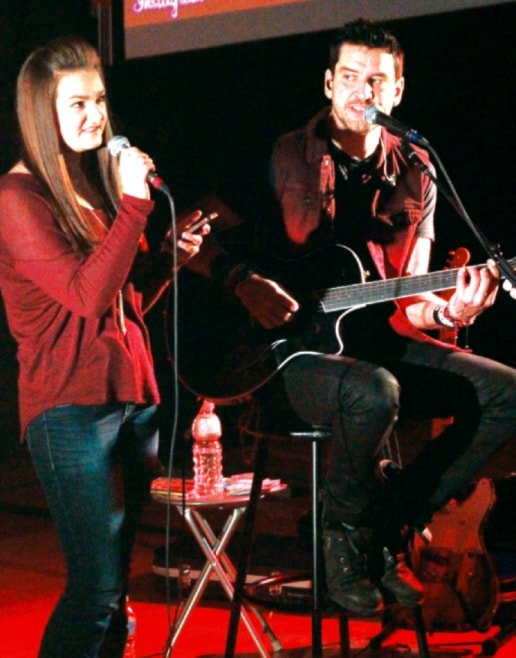After having taken a small group of students to see Robb Nash and his band perform in Ponoka, Rimbey’s Junior Senior High School social worker knew the group needed to come to Rimbey to spread their message.
“It’s a powerful message. Basically it’s a powerful message of resilience,” said Margo Froehlick, school social worker. “It’s just an awesome mix of humor, music and message.”
Nash and his band toured Rimbey Junior Senior High School Feb. 27 after a $1,000 donation from the Lions Club helped make it possible. Nash doesn’t charge for his presentations because he’s conscientious of school’s budgets but welcomes donations to keep him going down the road.
Nash tours schools, reserves, prisons and detention centres across the country playing music; using the music and his own personal story to help people who are dealing with troubled times in their life, or providing words of encouragement and strength others can draw upon in the future.
At 17-years-old Nash was in a car accident, from which he died.
Miraculously his heart began beating again but his family was told he’d never awake from his coma, which he also did.
It was a day wrought with icy roads and terrible weather conditions when teenage Nash and his friend decided to take a drive, rushing down the highway at 120 km/h. They pulled out to pass a car and found themselves face to face with a semi-truck. Nash’s friend hit the brakes, but they collided. “We hit this semi-truck head on.”
Nash told the junior and senior high students of Rimbey’s school as well as Bluffton Junior High, Rimbey Christian Junior High and West Country Outreach School about his accident with good humor and an upbeat pace but topics covered in his presentation were decidedly less funny yet very necessary to speak to students about, as hardships and feelings of anger, bitterness and despair are universal to youths and adults alike.
It was several months before Nash was fully out of his coma and could remember who he was, although he was no memory of the accident, and his life was vastly different from the way it was one second before the two vehicles collided.
Gone were his hopes of a sports career because of the damage to his head and, for the longest time, basic functions he’d known since childhood. “I was 17-years-old and couldn’t bath without my mother’s help.”
“I started hearing voices in my head and it terrified me. They said ‘you’re useless now, there’s no reason’.” For a year after his accident Nash didn’t want to continue living.
Eventually there was a change in Nash. “I had the potential to be angry the rest of my life or I could do something.”
His first decision was to call the semi driver also involved in the accident to let him know he was alive. “We talked for like two hours and when I hung up I could feel that guy was set free.”
“I was jacked, I’d never done anything for anyone besides myself before,” he added.
Growing up, Nash never would have figured music would be part of his future. His worst marks in school were in music class and he was told he wasn’t good enough to make the school’s choir.
However after his accident Nash wanted to tell his story. He found himself in an unthinkable place with a record deal playing for huge crowds and songs on the Top 40. Then he was asked to go on tour to visit and inspire schools, prisons, reserves and detention centres. “I was like ‘yeah’ and my record label was like ‘no’’”.
To take the tour Nash had to rip up his recording contract as well as publishing and management deal.
The charismatic and humorous man told a completely rapt audience of junior and senior high school students that life is painful but it doesn’t need to define your every action. “Pain doesn’t go away, but neither does your strength.”
While he didn’t dwell on the adverse effects of pain, Nash didn’t sugarcoat life for the students. He used his presentation to talk about strengths and solutions without trying to force change within the kids. “We’re not trying to change the world here, we’re trying to create world changers.”
Life is about more than trying to learn from personal mistakes, it’s also about learning from those around you, Nash told the students.
After touring across the country Nash has had both students and teachers hand him suicide notes they no longer needed as well as razors and bracelets covering scars because he’d helped them find the strength within themselves.
Nash has received messages months, sometimes even years after a performance thanking him for his message, his words and non-judgmental support. Other messages have been of regret and lament, asking for his help because they didn’t listen to his message the first time and made a bad choice.
In the beginning of his presentation Nash talked about choices and fate. In the time following his accidents he found people would try and comfort him by saying, “everything happens for a reason” or “it was fate.”
“I was like, if this is fate it sucks,” said Nash. He told the students that one day someone told him they figured out the reason he’d been in the accident, after the cliché began to haunt him. That person said it was because he was speeding down an icy road, and Nash knew from then on the accident hadn’t been fate because that implied no choice. “But I made the choice to get into that car.”
Froehlick says Nash’s presentation benefits the students because it can provide them with hope for feelings or situations they can relate to. “Maybe this will give students courage to talk to parents or adults in their life.”
